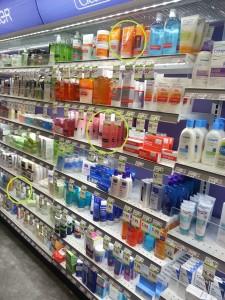Vacationing at the beach always provokes amazing sensory experiences. Everything about lounging in the sand soaking up sunshine, hearing waves crash along the shore, feeling a gentle breeze, and watching a sunset infused with citrus colors relaxes the mind, body, and soul. Now picture an arc of sparkling white turbines dotting the horizon and reflecting the setting sun, their blades twirling as waves tumble below. The image in itself is striking, made only more majestic by the prospect of a clean energy future. The ability to build turbines that each produce 6 megawatts of clean energy in offshore locations seems unreal. Wind capturing technology has made incredible strides since grain-grinding mills first became widespread, but something is holding it back from reaching its potential.
Tag Archives: Water
Solutions to Water Micropollution

North River Wastewater Treatment Plant in New York City with a boat. Image courtesy of Wikipedia Commons
Every time people use water, it goes back down the drain less purified and clean than it was when it came out of the faucet. People, especially in the United States, take water accessibility and purity for granted so it is easy to forget about the implications of polluting water after use. While water may appear to be clean, it is often times contaminated with micropollutants after human use. Micropollutants are widely misunderstood because they are not easily found or observed. They are organic, mineral, or synthetic substances that accumulate in the environment and can have a negative affect on organisms because of their toxic nature. This definition exemplifies the “pollutant” part of micropollutant, but micropollutants are also characterized by the small size. These substances are found to be as small as a few atoms that make a molecule to as large as 5 mm in diameter. Three types of pollution that were previously discussed in depth are pharmaceuticals, antibacterial active ingredients, and microplastics.
Are Fish and Plants on Antidepressants?
- Prozac: an antidepressant with Fluoxetine. Image courtesy of Wikipedia Commons
What happens when people take prescribed medications? The obvious, immediate effect is helping the person with their ailment, but unfortunately, drugs are also getting into the environment through wastewater and are harming aquatic life. When people are prescribed pharmaceuticals, the patients’ assumptions are that their bodies absorb all of the chemicals and that is what causes them to feel better. In actuality, the body usually interacts with the medication, but the active chemical can sometimes remain undisturbed and is eventually secreted from the body as waste in the bathroom. The water is then treated, but not on a small enough scale to filter out most pharmaceuticals. Once the wastewater is integrated into lakes and streams, the drugs are still present in the water and wildlife is exposed to human medication.
One type of drug that is consistently found in aquatic environments is fluoxetine. Fluoxetine is the active ingredient is Prozac, an antidepressant medication that can also be used to reduce the negative symptoms of anxiety and obsessive-compulsive disorders on patients. Fluoxetine works by increasing the activity of serotonin in the brain, a chemical responsible for giving people a sense of happiness.
The Dangers of Antibacterial Soap

Hand soap with Triclosan. Courtesy of CAPL Washington and Jefferson College
When buying soap and cleaning products, most consumers purposefully purchase brands that are known for being antibacterial. It has been well advertised that antibacterial products are necessary for keeping people and their families safe from getting sick; as it turns out, this assumption that antibacterial is better is not being confirmed by modern research. Additionally, the active ingredient in antibacterial soap, triclosan, is bad for the environment and potentially dangerous for humans.
Triclosan is a molecule that contains mostly carbons and chlorine, and was first patented in 1964. While that molecular makeup seems harmless, especially considering all healthy, organic compounds contain carbon and chlorine is a common atom that humans are exposed to, the particular structure may actually be detrimental to the environment and human health.
Continue reading
Face wash: A Major Contributor to Micropollutants in Water

The products enclosed by green circles have plastic exfoliating beads (2014). Photo courtesy of Gwen Gallagher
Facial washes are extremely popular products used for deep cleanses and are an integral part in most people’s daily routine. They are especially helpful for preventing acne and giving the consumer a refreshed feel. Some face washes contain exfoliating beads to improve the soap by mechanically removing the outmost layer of skin. The beads help remove dead skin layers and any debris from the day to reveal smoother skin and facilitate the growth of healthy, rejuvenated skin. The exfoliating beads tend to be made of out plastic and were considered ideal for the consumer because of the guaranteed smooth surface, which reduces the potential for redness and irritation of the skin. Unfortunately, the beads are so small that they can slip through water treatment facilities and plastic is not easily degradable. As a result, plastic microbeads are accumulating in marine environments and posing a threat to the organisms.

